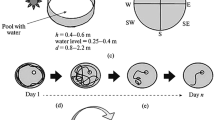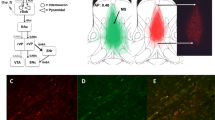Abstract
Chronic morphine impaired acquisition of two dissimilar behavioral tasks. In the radial maze, the performance of saline-treated and morphine-treated groups diverged with the latter failing to improve despite extensive training. In contrast, rats treated with naltrexone became skilled in the procedure 2–4 times as rapidly as saline controls. Withdrawal of treatment significantly improved performance of morphine-treated rats, with no change for rats treated with saline or naltrexone. When a second group of rats was extensively trained prior to instituting chronic morphine treatment, performance scores were not affected, suggesting that morphine does not impair spatial working memory despite subjective evidence of other gross behavioral effects, such as ataxia. In the Y-maze choice escape task, acquisition of a response strategy was significantly impaired in rats that had been previously treated with morphine for 17–21 days, despite clear indications that morphine-treated rats were sensitive to the aversive stimulus.
Similar content being viewed by others
References
Berge O-G, Garcia-Cabrera I, Hole K (1988) Response latencies in the tail-flick test depend on tail skin temperature. Neurosci Lett 86:284–288
Canli T, Cook RG, Miczek KA (1990) Opiate antagonists enhance working memory of rats in the radial maze. Pharmacol Biochem Behav 36:521–525
Castellano C (1975) Effects of morphine and heroin on discrimination learning and consolidation in mice. Psychol Rep 60:1099–1105
Cipolli C, Galliani I (1981) Addiction time and intellectual impairment in heroin users. Psychol Rep 60:1099–1105
Flood JF, Cherkin A, Morley JE (1987) Antagonism of endogenous opioids modulates memory processing. Brain Res 422:218–234
Gallagher M (1982) Naloxone enhancement of memory processes: effects of other opiate antagonists. Behav Neural Biol 35:375–382
Gallagher M, King RA, Young NB (1983) Opiate antagonists improve spatial memory. Science 331:975–976
Guerra D, Sole A, Cami J, Tobena A (1987) Neuropsychological performance in opiate addicts after rapid detoxification. Drug Alcohol Depend 20:261–270
Introini I, McGaugh JL, Baratti CM (1985) Pharmacological evidence of a central effect of naltrexone, morphine and betaendorphin and a peripheral effect of met-and leu-enkephalin on retention of an inhibitory response in mice. Behav Neural Biol 44:434–446
Izquierdo I (1979) Effect of naloxone and morphine on various forms of memory in the rat: possible role of endogenous opiate mechanisms in memory consolidation. Psychopharmacology 66:199–203
Izquierdo I, McGaugh JL (1985) Delayed onset of the amnestic effect of posttrainingβ-endorphin: effects of propranolol administration prior to retention testing. Eur J Pharmacol 113:105–108
Jackson RL, Alexander JH, Maier SF (1980) Learned helplessness, inactivity, and associative deficits: effects of inescapable shock on response choice escape learning. J Exp Psychol 6:1–19
Jaffe JH, Martin WR (1985) Opioid analgesics and antagonists. In: Gillman AG, Goodman LS, Rall TW, Murad F (eds) The pharmacological basis of therapeutics. Macmillan, New York, pp 491–531
Levin ED, Castonguay M, Ellison GD (1987) Effects of nicotinic receptor blocker mecamylamine on radial maze performance in rats. Behav Neural Biol 48:206–212
Levine JD, Feldmesser M, Tecott L, Gordon MC, Izdebski K (1984) Pain-induced vocalization in the rat and its modification by pharmacological agents. Brain Res 296:121–127
Logan FA (1968) Incentive theory in changes in reward. In: Spence KW, Spence JT (eds) The psychology of learning and motivation, vol 2. Academic Press, New York
Martin WR (1984) Pharmacology of opioids. Pharmacol Rev 35:283–323
Martinez JL, deGraaf JS, Chavkin C, Dana RC (1986) Leu-enkephalin actions on avoidance conditioning are mediated by a peripheral opioid mechanism. Life Sci 37:2345–2353
Messing RB (1988) Opioid modulation of learning and memory: multiple behavioral outcomes. In: Rodgers RJ, Cooper SJ (eds) Endorphins, opiates and behavioral processes. John Wiley, New York, pp 269–286
Morley JE, Levine AS, Yim GK, Lowy MT (1983) Opioid modulation of appetite. Neurosci Biobehav Rev 7:281–305
Moudy AM, Spain JW, Coscia CJ (1985) Differential up-regulation of microsomal and synaptic membrane μ opioid receptors. Biochem Biophys Res Commun 132:735–741
Olton DS (1987) The radial arm maze as a tool in behavioral pharmacology. Physiol Behav 40:793–797
Porro CA, Fields HL (1988) Immobilization and restraint effects on pain reactions in animals. Pain 32:289–307
Ragavan VV, Wardlaw SL, Kreek MJ, Frantz AG (1983) Effects of chronic naltrexone and methadone administration on brain immunoreactive beta-endorphin in the rat. Neuroendocrinology 37:266–268
Schulz R, Wuster M, Herz A (1981) Differentiation of opiate receptor in the brain by the selective development of tolerance. Pharmacol Biochem Behav 14:75–79
Spain JW, Newsom GC (1989) Chronic naltrexone enhances acquisition of the radial maze task in rats. Proc West Pharmacol Soc 32:141–142
Squire LR, Davis HP (1981) The pharmacology of memory: a neurobiological perspective. Annu Rev Pharmacol Toxicol 21:323–356
Strijkstra AM, Bolhuis JJ (1987) Memory persistence of rats in the radial maze varies with training procedure. Behav Neural Biol 47:158–166
Wallace JE, Krauter EE, Campbell BA (1980) Animal models of declining memory in the aged: short-term and spatial memory in the aged rat. J Gerontol 35:355–363
Yoburn BC, Morales R, Kelly DD, Inturrisi CE (1984) Constraints on the tail-flick assay: morphine analgesia and tolerance are dependent upon the locus of tail stimulation. Life Sci 34:1755–1762
Zukin RS, Tempel A, Gardner EL (1984) Opiate receptor upregulation and functional supersensitivity. NIDA Res Monogr 54:146–161
Author information
Authors and Affiliations
Rights and permissions
About this article
Cite this article
Spain, J.W., Newsom, G.C. Chronic opioids impair acquisition of both radial maze and Y-maze choice escape. Psychopharmacology 105, 101–106 (1991). https://doi.org/10.1007/BF02316870
Received:
Revised:
Issue Date:
DOI: https://doi.org/10.1007/BF02316870




